Enter the Axion
By Chanda Prescod-Weinstein
A new fundamental particle could solve a major puzzle in particle physics—and also explain the nature of the dark matter that permeates the universe.
A new fundamental particle could solve a major puzzle in particle physics—and also explain the nature of the dark matter that permeates the universe.

There are two ways to start a story about the axion. One is to explain that this hypothetical particle could be the key to a major problem in the Standard Model of particle physics, which describes all of the known fundamental particles. The beauty of the axion is that there is a second, equally significant beginning to its story. We now suspect the axion may also be the answer to one of the most important questions—if not the most important question—in all of particle physics and astronomy: What is dark matter?
Dark matter is the term that researchers use for the invisible substance that seems to dominate the formation of cosmic structure and to make up the majority of all tangible matter in the universe. The first thing I like to tell people about dark matter, to help them develop some intuition for this strange idea, is that dark matter is a terrible name for this stuff, whatever it is. The term is often attributed to Swiss astrophysicist Fritz Zwicky, who proposed the existence of dunkle Materie in 1933, but in fact the first articulation of something like it goes back to 19th-century scientist William Thomson, better known as Lord Kelvin. In 1884, Kelvin first spoke of “dark bodies,” proposing that there might be celestial objects that do not radiate light or other energy, making them difficult to detect with our astronomical instruments.
The modern conception of dark matter draws on this apparently intuitive idea that something that does not radiate is dark. But the dark matter problem we are dealing with is much more fantastic than that: We are contending with a type of matter that simply does not interact with light or other radiation. This property is why dark matter is a terrible name: We can see matter that is dark. We can see dark hair, for example, when light scatters off it into our eyes. A better name would be invisible matter, transparent matter, or clear matter.
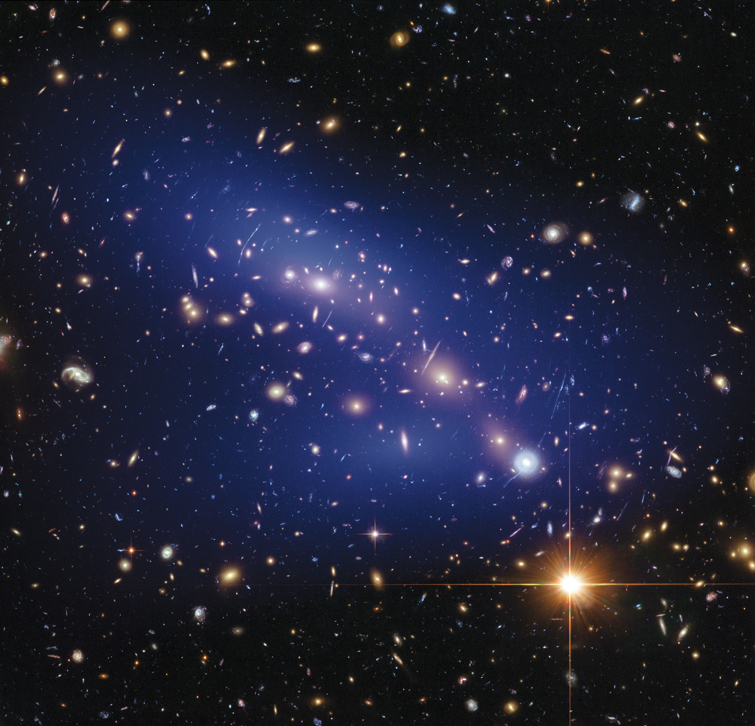
NASA, ESA, D. Harvey (École Polytechnique Fédérale de Lausanne, Switzerland), R. Massey (Durham University, UK) and HST Frontier Fields
The first substantive evidence for the existence of dark matter came from the work of astronomer Vera Rubin in collaboration with Kent Ford. Using an instrument Ford developed, Rubin looked at the speeds of stars as they orbited the center of their galactic homes. What she found was inconsistent with what one might expect based on estimates of the galaxy’s mass that researchers made by using stars. If the stars were all of the matter in the galaxy, they should have been orbiting more slowly. The stars were moving as if there was more matter than astronomers could see. In other words, the data indicated that there was a lot of matter on the outer edges of the visible parts of the galaxy—matter that wasn’t radiating but was nonetheless gravitationally influential.
Today, there is a plethora of evidence for the existence of this missing dark matter. Besides Rubin and Ford’s galaxy rotation curves, we now know plenty about clusters of galaxies, galaxy mergers, and other aspects of cosmic structure formation. Moreover, our evidence goes beyond the galactic and even comes from a time long before galaxies had formed. Data from cosmic microwave background (CMB) radiation—the first light to travel freely in a transparent universe after the post–Big Bang plasma cleared—match best with a model that includes dark matter. Indeed, CMB data are currently the strongest evidence for dark matter.
We also know that dark matter is a totally different substance from any of the particles in our elaborate Standard Model of particle physics. The best way to develop an intuitive feel for this concept is to understand that most of those particles would radiate in ways that dark matter does not. No particle in the Standard Model has the right properties to be the dark matter.
The idea that most of the matter in the universe is something we’ve never seen or touched might seem implausible. How do we know it’s there? Is it truly the case that we, along with stars, dust, and everything else that is luminous, are a demographic minority in the universe? Spend some time thinking about these questions, and you may find it difficult to stop. This could seem like a problem to someone who isn’t a scientist, but from the point of view of a theoretical physicist, it is a wonderful problem to have.
Over the past several decades, many theoretical physicists have taken up the task of trying to solve the dark matter problem. Accounting for all of the hypothetical particles proposed to explain it is like trying to describe all the denizens of an enormous menagerie. For a while, many researchers placed their hopes on candidates inspired by a theory called supersymmetry. These models were tested using CERN’s Large Hadron Collider or in giant underground detectors such as Large Underground Xenon (LUX) in South Dakota and XENON1T in Italy. The lack of a discovery or even a hint of discovery during the past decade sent many physicists back to the drawing board in search of a new dark matter particle to research. As a result, over the past few years one candidate that can be detected through other mechanisms and had previously garnered relatively little attention has swelled in popularity: Enter the axion.
We are contending with a type of matter that simply does not interact with light or any other form of radiation.
I didn’t always believe that dark matter was so important. In fact, I used to think dark matter was a boring, fringe problem in particle physics that would get sorted soon enough. For a long time I thought the only great challenge of our time was cosmic acceleration, perhaps because scientists discovered it the year I applied to college. It’s easy to think my youthful ignorance drove this, but it’s also the case that everywhere I looked, there were exciting conversations about dark energy happening. (Despite their similar-sounding names, dark matter and dark energy are ideas that address distinctly different problems.)
During the summer after my first year of college, I had the opportunity to spend a few months doing research in particle physics. During that time, I had the opportunity to visit Fermilab, where I saw a talk by distinguished theoretical physicist, Edward “Rocky” Kolb. It was 2000, just two years after astronomers had discovered that the universe is not only expanding, but that its expansion is also accelerating. Reconciling this new empirical data about cosmic acceleration with our best theoretical framework for gravitation—general relativity—led to the idea that space is filled with an unseen energy known as dark energy.
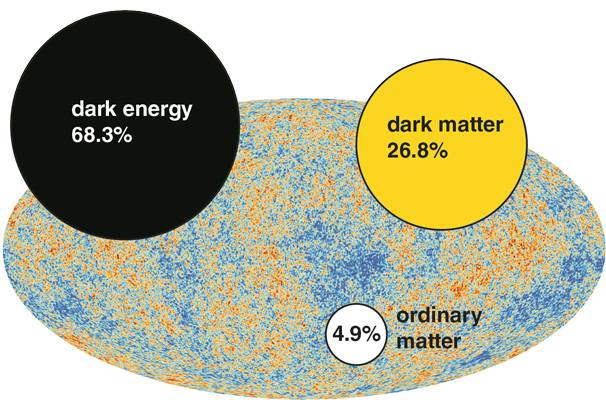
Barbara Aulicino; ESA and the Planck Collaboration
As a result, Kolb opened his talk—to the best of my recollection 21 years later—by saying that cosmologists had worked out the universe’s composition. It was 5 percent “normal” everyday matter, 20 percent dark matter, and 70 percent dark energy. We were almost there, he said. We just needed to figure out what dark matter and dark energy were, and we would be done. It’s a funny story, and part of what’s funny about it is that I figured we’d soon find dark matter and that dark energy was the only real mystery.
Dark matter has a way of drawing you in though, and for me the tug came through axions. Today I am known by colleagues around the world to be an expert on this particle. To understand how a scientist like me gets captured by a particle that isn’t even necessarily real, it’s important to go back to that particle’s origin story—to the strong CP (charge conjugation and parity) problem.
The axion began as a solution to a problem in the Standard Model of particle physics—specifically, the part built on the theory of quantum chromodynamics (QCD), which governs the fundamental particles we call quarks and gluons. QCD is highly successful, but it predicts properties we’ve never seen in the neutron (which is made of quarks). To understand that problem, it’s important to know some basics about the math behind the elaborate artifice of the Standard Model.
There is a specific recipe for writing down new ideas in particle physics. We use an equation that we call the Lagrangian that is meant to characterize a particle’s properties and from which we can derive the equations that predict the particle’s behavior in space and time. The most fundamental ingredients for this equation are components that describe the different types of energy that characterize a particle. Additional “spices” include how the particle interacts with other particles. As with baking, there are very specific rules about how to add these components and to make sure that they don’t do too much or too little. Many of these rules are built on the expectation that each term in the Lagrangian will remain the same if we carry out a mathematical operation associated with a symmetry on them.
This process might sound complicated, but we are very familiar with symmetries in our everyday lives. A circle, for example, is symmetric: No matter how we rotate it, every spot on the circle is the same as every other spot. In other words, when you rotate a circle around its center, it will always look the same. This property is a rotational symmetry. The symmetry can be broken if, for example, I draw a dot in one place on the circle. Now there is a special place on the circle, and rotating the circle changes the location of the special place.
There was new physics out there waiting to be theorized. The axion emerged from one of these searches.
An example of a symmetry we might require a Lagrangian to have is time-translation invariance—that is, if we change the time interval we put into the equation, the answer remains the same. The Earth’s gravity is the same day and night. It is time-translation invariant. If a term that we are thinking about adding to the equation doesn’t respect a symmetry that we know or theorize to be important, we discard that term. If your hypothesis contains an equation indicating that gravity changes from time to time, it is dead on arrival. From a physical standpoint, these symmetries imply the existence of conservation laws, ensuring that, for example, we can’t create an electric charge out of nothing.
From a mathematical perspective, the Standard Model is a lengthy Lagrangian with many terms, describing all of the particles we have ever seen. Scientists have developed this formulation of particle physics through a mix of theoretical and experimental trial and error. Where experiment hinted at the need for new terms, theorists wrote down models with hypothetical symmetries and checked if they matched the data. Sometimes these models matched the data but indicated there were more particles out there, yet undetected. Sometimes models matched the data, but then new data came in suggesting that the model wasn’t rich enough: There was new physics out there waiting to be theorized and observed. The axion emerged from one of these searches for new physics.
The dynamical relationship between theory and experiment has led to many successful developments in particle physics. One example is the discovery of the top quark, which was predicted in the 1970s but wasn’t observed until 1995. Starting in the 1960s, experiments with an unusual particle called a kaon indicated that when it decayed, there were violations of charge conjugation parity (CP) symmetry. This symmetry has two components: Charge conjugation symmetry is the phenomenon where the physics of the system remains the same even if the sign of the particle’s charge changes from positive to negative or vice versa. A phenomenon or object that has parity symmetry has the same physical outcome despite a change in the sign of its spatial coordinates (flipping it right-left or top-bottom). Taken together, charge conjugation and parity symmetries are known as CP symmetry. Importantly, CP symmetry means that matter and antimatter should behave similarly. (For more information on antimatter, see “The Origin of Matter,” March–April 2004.)
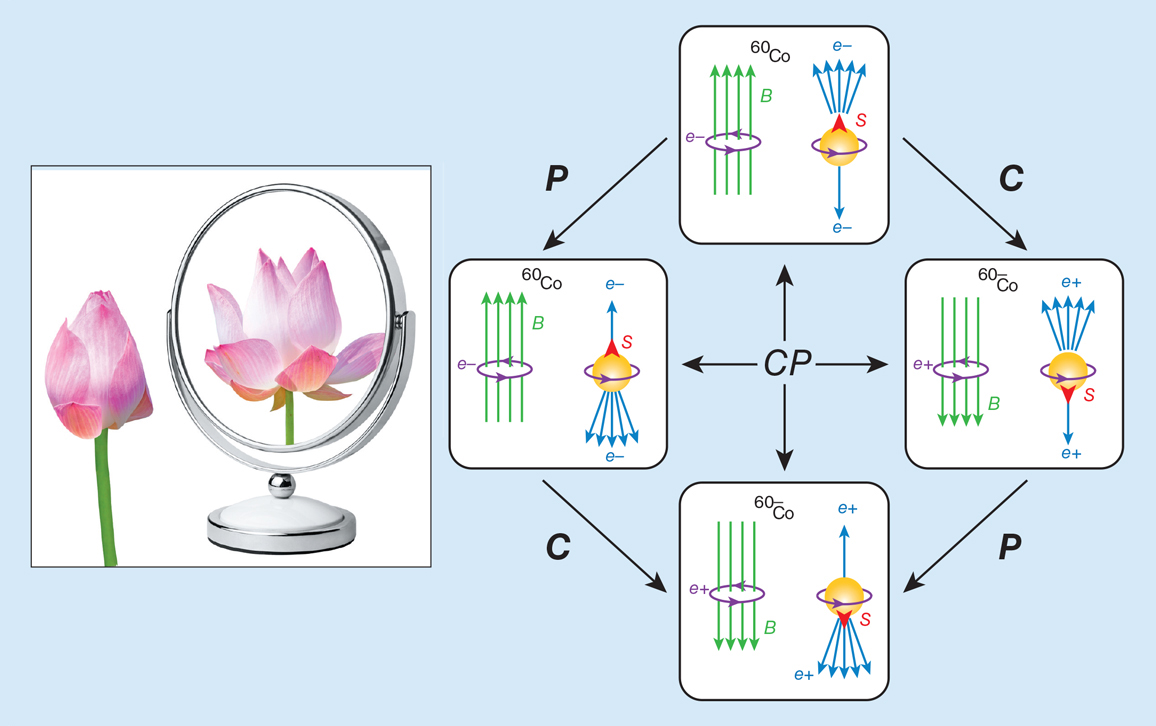
Barbara Aulicino/photos Andrey Elkin; janniwet wangkiri/Alamy Stock Photo; UK Open Educational Resources/CC BY-NC-SA 2.0
Kaon decays displayed evidence of CP symmetry violations, which hinted that the original formulation of QCD did not have enough quarks in it. Quarks are fundamental particles that comprise other particles, notably protons and neutrons that are each composites of two types of quark: the up and the down quark. At the time of the kaon decay experiments, there were four known types of quarks. Based on the experimental results, Makoto Kobayashi and Toshihide Maskawa at Kyoto University proposed the existence of two additional quarks, known today as the top and bottom quarks. Though they made this prediction in 1973, the top quark was not observed until 1995 because it was too heavy to be observed with technologies available in the 1970s.
The axion is pretty much everything we know enough to want in a dark matter candidate.
Today a similar hunt is on for experimental evidence of CP symmetry breaking in other parts of QCD. Specifically, a term can be added to the QCD part of the Standard Model Lagrangian that does not obey CP symmetry. This violation becomes an issue when we consider the experimental implications: The additional term gives the neutron an electric dipole moment, meaning that some parts of a neutron should have a measurably positive or negative local charge. So fine, you say, the neutron has an electric dipole moment. That’s a bit strange, because it’s supposed to be a neutrally charged (zero charge) particle, but things get weird in particle physics, you admit.
The only problem? There’s no experimental evidence for a neutron electric dipole moment, and as of last year, the experimental constraints on it are so good that we can say with confidence that the likely value is zero. The theory suggests there should be CP symmetry violation, but there is no experimental evidence of it happening in what we call “the strong sector,” which is the part of the Standard Model where the strong force is dominant. This is known as the strong CP problem.
In part because this problem has not been resolved, the Standard Model—despite all its successes—remains incomplete, even when we ignore the looming dark matter problem. The axion, it turns out, first arose in response to this challenge during the same time period when Rubin and Ford were discovering that dark matter was a real problem to be solved.
Roberto Peccei and Helen Quinn developed the current, most popular solution to the strong CP problem at Stanford University in the 1970s. The Peccei-Quinn mechanism, as it is now known, upgrades a constant variable in the CP-violating term to a dynamical variable that “relaxes” to zero, canceling the neutron electric dipole moment. It was realized soon after they first published their idea that this mechanism led to the production of a new, hypothetical particle. Inspired by a brand of laundry detergent, theoretical physicist Frank Wilczek named the particle axion, which in turn got its name “Axion” from Greek Orthodox liturgy.
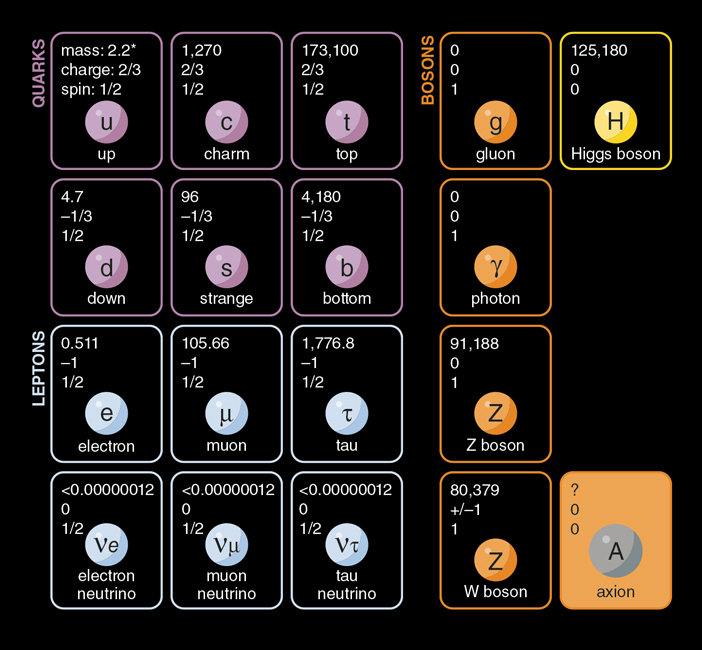
Barbara Aulicino
In the early 1980s, papers on the potential observational consequences of the hypothetical axion proliferated, including suggestions by theorists such as University of Florida physicist Pierre Sikivie that the axion had exactly the right properties to solve the dark matter problem. Thanks to observational data, we know that the dark matter particle must be low in mass, uncharged, long-lived and slow-moving. Ideally, there should also be an obvious mechanism for producing many of the dark matter particles in the early universe. The axion can satisfy these requirements. It is pretty much everything we know enough to want in a dark matter candidate, except that we’ve still never seen it and don’t know for sure that it’s real.
Dark matter is writ large on our sky. Because of gravity’s tendency to pull things together, dark matter dominates the formation of the universe’s biggest visible structures, such as galaxies and galaxy clusters. We can learn a lot about what properties dark matter needs to have from studying cosmic structures and their formation. We can infer that dark matter particles must be long-lived and not flicker in and out of existence over short time scales, for example, because otherwise they wouldn’t last the necessary billions of years to have the gravitational influence necessary to grow a galaxy. The details of the dark matter particle’s properties have implications for not only the particle but also the large-scale evolution of our universe.
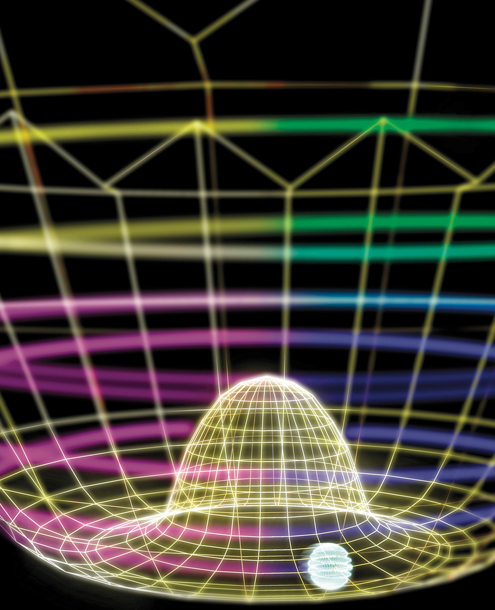
Ramon Andrade 3DCiencia/Science Source
In the end, I came to the dark matter problem through questions about the cosmological evolution of axions. In the early 2010s, physicists debated about what kinds of quantum states in which axions would typically find themselves, and part of the debate was about how to do the calculation that would check this. I initially arrived at axions because I was interested in the technical questions behind these calculations. The axion is a distinct dark matter candidate not just because of its specific microphysical properties or because we need it regardless of its relationship to the dark matter problem, but also because those properties can translate into astrophysical signatures that are different from those produced by other dark matter candidates. There is something of a raging debate in the field about the extent of these differences between dark matter models.
Unlike most dark matter candidates, for example, axions have zero quantum mechanical angular momentum, making them what we call scalar boson particles. Bosons are one of two possible quantum classes of particles, the other being fermions. Most other hypothetical dark matter particles are fermions. The difference between bosons, such as axions, and fermions can be stark, because all fermions cannot share the same quantum mechanical state. This rule explains why electrons end up in different atomic orbitals. Bosons, on the other hand, have no problem sharing a state. They’re a bit like the pep squad and are able to completely sync up. A remarkable outcome of this ability is the Bose-Einstein condensate, in which many bosons share the same low-energy state and behave like one single super-boson. We know the Bose-Einstein condensate is a real phenomenon because we’ve been watching it in the lab with atoms for almost 25 years. Now we wonder, is it happening in space, with dark matter? If so, it could profoundly influence the structure and evolution of the universe.
The devil is in the details. This question is an important one, but there are others that follow in its wake. If there is such a thing as Bose-Einstein condensate dark matter, we would like to know what types of objects it typically forms: their typical mass and length and how they interact with one another. In 2014, along with fellow Massachusetts Institute of Technology (MIT) postdoctoral researcher Mark Hertzberg (now at Tufts University) and our postdoctoral mentor, Alan Guth, I set out to test a claim that the scale of these Bose-Einstein condensate axions would be enormous—galaxy-size enormous. We found the opposite. Assuming the properties of the original QCD axion Peccei and Quinn predicted in the 1970s led us to something more like asteroid-sized axion condensates, or axsteroids as my collaborator Anna Watts at the University of Amsterdam has dubbed them.
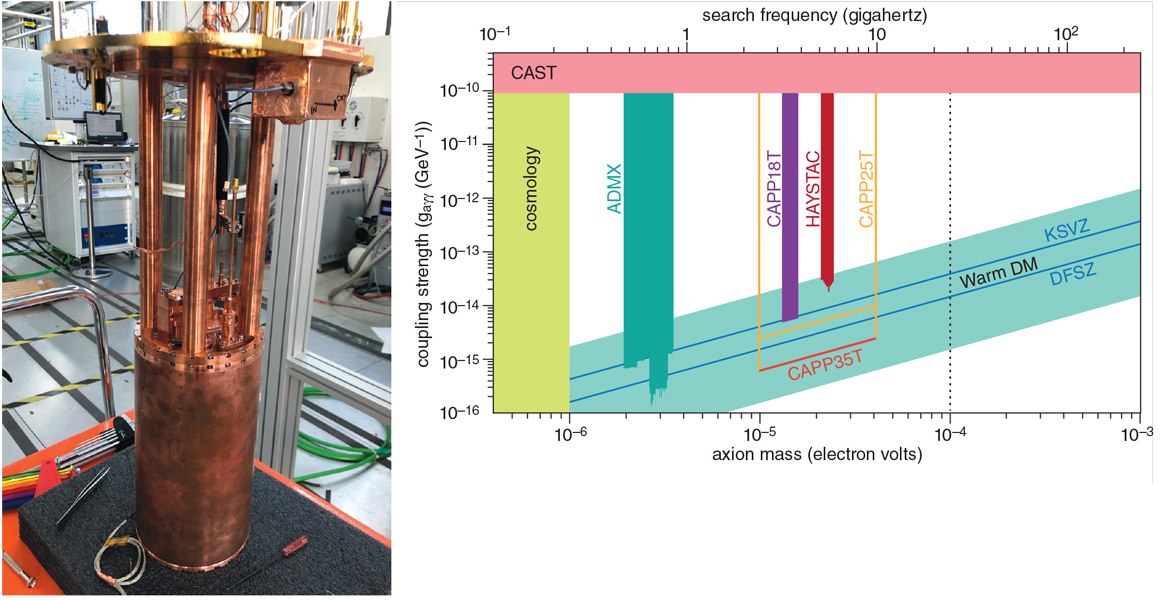
Courtesy of Soohyung Lee/ Center for Axion and Precision Physics Research, Institute for Basic Science
These kinds of hypothetical calculations of what astrophysical phenomena axions might produce are valuable because we can compare them with observations to see if the axion makes sense as a dark matter candidate. Today my research centers primarily on developing robust calculational tools for modeling axions in space. This research includes work with my colleagues Kay Kirkpatrick and Tony Mirasola at the University of Illinois at Urbana-Champaign. We are trying to understand exactly what mathematical techniques are necessary to account for all of the axion’s properties. This work has implications for what we put into computer simulations designed to model the halo of dark matter thought to surround our galaxy.
The observational implications of axions are still not totally understood across different possible masses for the particle. We find that lighter axions could form a galaxy-halo–sized condensate. The heavier ones may form axsteroids in the early universe, but we don’t know yet what they do at later times—specifically, at the time in which we now live.
Astronomical studies can provide only indirect indications of the axion’s properties and behavior. Ideally, we want to characterize axions more directly by detecting them with experiments designed for this purpose. Direct detection would almost certainly yield more information about the axion’s specific properties, and also allows us a level of certainty that may always elude us as long as we are reliant on astronomy to provide us with all of our data. One reason to worry is that two different hypothetical particles might produce similar large-scale structures. We might not be able to tell the difference just by looking at astronomical data.
Happily, despite the fact that dark matter typically doesn’t radiate and light typically passes right through it, it’s possible this isn’t always the case. Under certain conditions—we hope—dark matter candidates may interact with photons (particles of light) or other known particles. These interactions would produce unique observable effects that may allow us to determine the identity of dark matter and to characterize the properties of the particles. This method is how much of experimental research in particle physics is done.
Under the right conditions, the axion has what we call a “coupling,” or interaction, with the electromagnetic field, which is a fancy way of saying that it can interact with light if we correctly tune the environment. In the presence of an extremely intense magnetic field, a QCD axion should decay into microwave-frequency photons that could be measured and detected. The Axion Dark Matter Experiment (ADMX), located at the University of Washington, is testing this phenomenon using an 8-tesla magnetic field, about 100,000 times as powerful as Earth’s magnetic field, to search for evidence of QCD axions.
We are hunting, ultimately, for a richer understanding of the mathematical tapestry that describes our universe.
I’ve made this experiment sound simple, but it’s actually pretty difficult work. Tuning the magnetic field and making sure the microwave cavity doesn’t have noise—accidental photons caused by something else—is key to preventing a false discovery. The Peccei- Quinn model does not tell us what the strength of the relationship between the magnetic field and the axion may be or the mass of the axion. So the ADMX experiment must look for a whole range of possible axion properties rather than focus on one area in particular.
To make things more complicated, today “the axion” doesn’t refer just to the original QCD axion derived from the Peccei-Quinn mechanism. It turns out that the quantum gravity model known as string theory has many particles in it with properties very similar to the QCD axion, and physicists have now loosely classified them all as axions too, even though they do not have the properties to solve the strong CP problem. Those of us who are careful use the term “axion-like particle.” Not everyone is so careful, however. These days when I give talks to audiences of physicists, I include a slide where I explain axion nomenclature, including terms such as “ultralight axion,” which refers to very low-mass string-theory–inspired particles.
Because axion-like particles don’t have to solve the strong CP problem, there are fewer constraints on their potential properties. Ultralight axions and other axion-like particles could have a wider range of interactions with the electromagnetic field and have a broader range of masses than the more constrained QCD axion. There is more freedom, which is great fun for theorists but also creates an empirical challenge. Looking all over parameter space for axion-like particles is a difficult (but entertaining!) slog.
When I first started working on axions in 2014, it seemed like the most active interest in the particle was coming from my colleagues in Europe and Asia. Things are dramatically different in 2021. It seems like everyone is talking about axions, and axions as a subject of research are everywhere. It may also be the case that axion particles are everywhere. We are certainly looking for evidence of them everywhere, both here on Earth and up in the heavens.
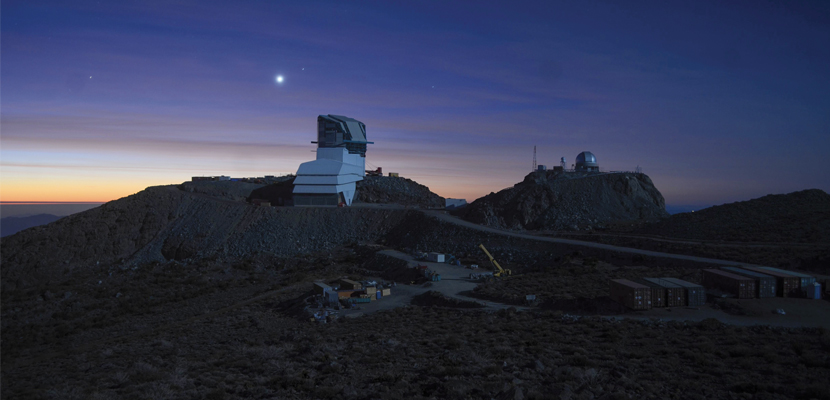
Courtesy of Rubin Observatory/NSF/AURA
ADMX continues to search for evidence of the QCD axion. In addition to ADMX, the ABRACADABRA (A Broadband/Resonant Approach to Cosmic Axion Detection with an Amplifying B-field Ring Apparatus) at MIT and several others housed at the Center for Axion and Precision Physics Research (CAPP) in South Korea are using related, magnet-based instruments to find direct evidence for the existence of the axion. Other researchers, including my group at the University of New Hampshire, in collaboration with colleagues at Stanford University and Fermilab in Illinois, are incorporating axions and axion-like particles into computer simulations that model the formation of galaxies. We then compare those simulations with observations of actual galaxies to see if axion dark matter leads to the right kinds of structures.
Our efforts to investigate the axion will expand greatly in the 2020s, as new astronomical facilities—such as the Vera C. Rubin Observatory (named for the woman who discovered the first conclusive evidence for dark matter)—start taking data. These facilities will map the structure of the universe and the inferred distribution of cosmic dark matter with unprecedented precision. We can also look for something akin to an ADMX in the sky. In this case, we are looking for celestial systems with a strong magnetic field. That means looking at neutron stars, which are extremely compact, dense objects that form at the end of the life of massive stars. Because of their collapsed structure, neutron stars often have extremely powerful magnetic fields. In theory, axions could interact with these magnetic fields to produce unexpected emission of radio waves. One research group recently reported tentative evidence of such emissions, although I remain skeptical about this claim.
These efforts are easy to frame as a search for dark matter, but they are far more than that. The QCD axion is a byproduct of the Peccei-Quinn mechanism, and the strong CP problem remains unresolved. In other words, the hunt for axions is also the hunt for a more complete Standard Model of particle physics, and ultimately for a richer understanding of the mathematical tapestry that describes our universe.
Click "American Scientist" to access home page
American Scientist Comments and Discussion
To discuss our articles or comment on them, please share them and tag American Scientist on social media platforms. Here are links to our profiles on Twitter, Facebook, and LinkedIn.
If we re-share your post, we will moderate comments/discussion following our comments policy.